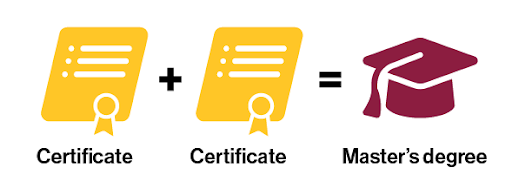
Beyond the traditional: How ASU's flexible programs meet global needs
This article is the first in a series on how reimagining graduate education can contribute to "solving global grand challenges." The topic of this article addresses the question, What if graduate students could design a master’s degree based on two or more topics that they want to study?
This year, the Graduate College theme is "Solving global grand challenges," which includes empowering students to customize their education by combining stackable certificates into personalized master’s degrees. This innovative approach allows students to align their career goals with the demands of the workforce and their interests.
Graduate students often tell me they pursue advanced degrees to elevate their careers. They understand that a graduate degree equips them with the knowledge and skills essential for success in the workforce. Employers, too, are increasingly specific about the skills they seek in their employees.
As we've discussed before, a master’s degree typically offers individuals the potential for higher income and greater job stability than just a bachelor’s degree.

We're enhancing student support by offering flexibility in designing their graduate education through stackable certificates. The Master of Advanced Study in advanced studies allows students to choose two graduate certificates from ASU, complete a single culminating project and earn a master’s degree. With over 110 graduate certificates available across all ASU colleges, the combination of possibilities is virtually limitless.
| Certificate #1 | Certificate #2 | Combined knowledge and skills |
|---|---|---|
| Digital Audiences | Nonprofit Leadership and Management | How nonprofit organizations can better engage their digital audience. |
| Clinical Research Management | Disability studies | Applying an understanding of the experiences of people with disabilities to improve medical science. |
| Biological Data Science | Sustainable Tourism | How sustainable tourism can benefit from citizen science data collection and analysis. |
| Health Care Innovation | Medical Nutrition | Improving nutrition through better healthcare interventions. |
| Lean Six Sigma Black Belt | Emergency Management | Equipping disaster managers with the skills to build teams and oversee continuous improvement projects. |
These and other combinations are particularly appealing because they give students more access and flexibility. Students can start with one certificate and then decide to continue their education. The flexibility lies in allowing students to choose the two certificates that best suit their interests. This approach also allows for interdisciplinary combinations, bridging different fields across colleges and intradisciplinary combinations, focusing on deepening expertise within a specific field. Either approach can significantly benefit students and their careers.
While other institutions offer stackable credentials, ASU’s model is unique. At many other universities, the stackable curriculum is predefined, guiding students toward specific certificates that contribute to a master’s degree. While these predefined paths provide credentials in targeted areas, they don’t offer the same level of customization that ASU does, where students can tailor their education to their unique career goals.
Some faculty might express concerns about the depth or rigor of these degrees or whether the chosen combination aligns with career aspirations. However, at ASU, faculty maintain full ownership of the curriculum. They design the certificates, teach the courses, oversee the culminating experiences, and evaluate learning outcomes, ensuring that the quality of education remains high.
The Council of Graduate Schools has noted that research on stackable credentials is still emerging. There is currently limited evidence from employers that students with these credentials are as well-prepared as those with traditional degrees. Additionally, some graduate deans have raised concerns about the relatively low enrollment numbers in certificate programs. We hope that the flexibility offered by the stackable option will encourage more students to enroll in these valuable programs.
This article describes how re-imagining graduate education can contribute to "solving global grand challenges.”
Other topics in this series will include:
- What if students could take one, two or three years off before returning to complete their accelerated master’s degree? What if students could switch modalities — complete their bachelor’s degree in person and their master’s degree online while sharing some coursework, and vice-versa?
What if graduate students could take degree programs designed for the local economy?
- What if graduate students could pursue flexible programs designed to be online with intentional immersion components?
- What if graduate students could earn admission into a master’s program via targeted courses as on-ramps?
- What if graduate students could be automatically admitted into ASU master’s degrees after earning their ASU bachelor’s degree?
Elizabeth Wentz
Vice Provost and Dean, Graduate College